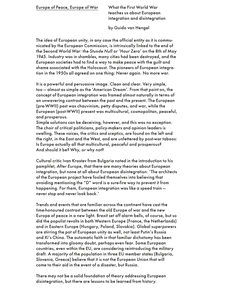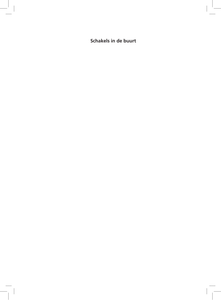Beknopte handleiding om een excursie naar de slagvelden rond Verdun te ondernemen of te organiseren. Naast praktische tips en websites ook korte overzichtsgeschiedenis.
DOCUMENT
Japan begon aan het einde van de 19e eeuw met het moderne concept ‘the movement of civilization’. Meer dan honderd jaar volgde Japan de westerse modellen van onder andere het sociale domein. Japan werd na de Tweede Wereldoorlog het eerste land in Azië met een verzorgingsstaat. Dit terwijl het sociaal werk in die tijd nog niet erkend werd.
DOCUMENT

The idea of European unity, in any case the official entity as it is communicated by the European Commission, is intrinsically linked to the end of the Second World War: the Stunde Null or 'Hour Zero' on the 8th of May 1945. Industry was in shambles, many cities had been destroyed, and the European societies had to find a way to make peace with the guilt and shame associated with the Holocaust. The pioneers of European integration in the 1950s all agreed on one thing: Never again. No more war. It is a powerful and persuasive image. Clean and clear. Very simple, too - almost as simple as the 'American Dream'. From that point on, the concept of European integration was framed almost naturally in terms of an unwavering contrast between the past and the present. The European {pre-WWII) past was chauvinism, petty disputes, and war, while the European {post-WWII) present was multicultural, cosmopolitan, peaceful, and prosperous. Simple solutions can be deceiving, however, and this was no exception. The choir of critical politicians, policy-makers and opinion leaders is swelling. These voices, the critics and sceptics, are found on the left and the right, in the East and the West, and are unfettered by post-war taboos: Is Europe actually all that multicultural, peaceful and prosperous? And should it be? Why, or why not? LinkedIn: https://www.linkedin.com/in/guido-van-hengel-8312729/
DOCUMENT

Op donderdag 22 mei 2014 worden in Nederland de verkiezingen voor het Europees Parlement gehouden. De burger wordt in staat gesteld zijn/haar vertegenwoordiger in dit parlement rechtstreeks te kiezen. Er wordt tegenwoordig veel over Europa gediscussieerd. Dat is op zich een goede zaak. De discussie moet echter wel op een evenwichtige wijze plaatsvinden. Dat is niet altijd het geval. In het publieke debat wordt bijvoorbeeld het bestaan van de economische cisis vaak aan Europa verweten. Ook laten Europa-criticasters veel van zich horen. Daarentegen wordt weinig gehoord van de voorstanders van Europese samenwerking. In die zin is de betekenis van de verkiezingen aanzienlijk. Het is een testcase voor de geloofwaardigheid van het samenwerkingsproces in het algemeen en, belangrijker nog, voor de steun die Europa onder de bevolking geniet in het bijzonder. Mede vanwege de traditioneel lage opkomst voor de Europese verkiezingen (in Nederland in 2009 43,1%) is het goed een genuanceerd debat te stimuleren. Het is om die reden dat het lectoraat European Integration het plan heeft opgevat om naar aanleiding van de verkiezingen van 22 mei een publicatie het licht te doen zien waarin diverse aspecten rond de verkiezingen aan de orde komen, zoals: • Het al dan niet bestaan van een democratisch deficit in Europa; • De behoefte aan een Europese publieke ruimte; • De complexiteit van het besluitvormingsproces van de Europese Unie, in samenhang met de vraag hoe je dat uitlegt aan de burger • Aandacht voor de fundamentele waarden waarop het Europese integratieproces is gebaseerd; • De verantwoordelijkheid van de media bij de berichtgeving; • De betekenis van het Europees Burgerschap. Met deze publicatie hoopt het lectoraat bij te dragen aan een adequate voorlichting over het belang van de Europese verkiezingen. Het lectoraat is ook voornemens, parallel aan het gereedkomen van de publicatie een seminar op De Haagse Hogeschool te organiseren op donderdagmiddag 1 mei. Een openbaar debat met kandidaten voor de verkiezingen volgt op woensdagavond 14 mei in de Aula. Houd de website van het lectoraat www.dehaagsehogeschool.nl/lectoraat-eurint in de gaten! Komt allen en, belangrijker nog, breng uw stem uit op 22 mei!
DOCUMENT

Bijna tien jaar geleden publiceerde ik Grijs verleden, een geschiedenis van Nederland en de Tweede Wereldoorlog. In dit boek probeerde ik – in navolging van oudere historici als Hans Blom en Jan Bank en jongere historici-leeftijdsgenoten als Bart van der Boom, Kees Ribbens en Jan van Miert, onder de indruk van de recente onthullingen over de naoorlogse omgang met joodse mensen en goederen en aan het denken gezet tot slot door de gebeurtenissen in ondermeer voormalig Joegoslavië en Rwanda – een ander beeld van de oorlog te schetsen. Volgens mij, en daarmee beweerde ik niets nieuws, was het onjuist de oorlog telkens opnieuw vanuit het perspectief van onderdrukking en verzet te bekijken. Te midden van deze polen, zo beweerde ik, lag een breed veld vol schakeringen. Die schakeringen waren in de naoorlogse geschiedschrijving, met name in het werk van Loe de Jong en zijn ontelbare navolgers, onderbelicht gebleven en op dat moment slechts met betrekking tot enkele steden en onderwerpen beschreven. Het was tijd voor een veralgemenisering. Vandaar dat en en niet in van de ondertitel. Grijs verleden kon immers niet anders zijn dan zowel een polemiek met een beeld als een beschrijving van een andere historische werkelijkheid. Het boek maakte veel los. Veel negatieve en veel positieve reacties. Ook verscheen druk na druk. Pas na een jaar of twee werd het rustig. Tegenstanders bleven het een slecht werk vinden, voorstanders meenden het tegenovergestelde. De reden van een en ander werd me niet altijd even duidelijk.
DOCUMENT

Vanuit eerder onderzoek is het vermoeden ontstaan dat de inzet van buurtsportcoaches kan bijdragen aan allerlei maatschappelijke veranderingen waarvan we op dit moment geen of nauwelijks weet hebben of welke niet of nauwelijks aantoonbaar gemaakt kunnen worden. Voor de gemeente Den Haag is een breed inzicht in de opbrengsten van de buurtsportcoach van belang om een overwogen en onderbouwd besluit te kunnen nemen over de inzet van de buurtsportcoaches en sportstimuleringsprojecten. Het doel van dit onderzoek is daarom het inzichtelijk maken van de maatschappelijke veranderingen die buurtsportcoaches in Den Haag teweeg brengen. Daartoe worden in dit onderzoeksrapport maatschappelijke veranderingen beschreven die optreden als gevolg van de inzet van de buurtsportcoach in de gemeente Den Haag, in de perceptie van verschillende stakeholders. Het onderzoeksrapport – en met name het resultatenhoofdstuk – is als het ware een foto van de huidige situatie. Dit onderzoeksrapport bevat tevens aanbevelingen gericht op het versterken van maatschappelijke veranderingen die ontstaan door de inzet van de buurtsportcoach.
DOCUMENT

Hoofdstuk 4 in Schakels in de buurt. De wijk Randenbroek ligt in het zuidoosten van Amersfoort en grenst direct aan de binnenstad. Een eerste deel van de wijk stamt uit de jaren twintig en dertig van de vorige eeuw, maar de grootste uitbreiding vond vlak na de tweede wereldoorlog plaats, waarmee het gebied deel uitmaakt van een gordel van naoorlogse uitbreidingen rondom de binnenstad van Amersfoort. Er werden veel nieuwe woningen gebouwd, zowel flatgebouwen als eengezinswoningen. De woonwijk Schuilenburg stamt uit de tweede helft van de jaren zestig en sluit iets oostelijker op Randenbroek aan. Schuilenburg is meer eenvormig gebouwd, hoewel er wel sprake is van een duidelijk verschil tussen het noorden en het zuiden van Schuilenburg. Schuilenburg-Noord heeft langs de randen van de buurt veel goedkope portiek- en galerijflats uit de jaren vijftig en zestig van de vorige eeuw; in Schuilenburg-Zuid staan duurdere koopwoningen en appartementen
DOCUMENT

Deze publieksrapportage geeft een samenvatting van de resultaten die staan weergegeven in de onderzoeksrapportages: ‘Iedereen telt mee: ETHOS telling van dak- en thuisloosheid in regio Meierij en Bommelerwaard’ en ’Iedereen telt mee: ETHOS telling van dak- en thuisloosheid in regio Brabant Noordoost-Oost’.
DOCUMENT

Wageningen wordt vanwege haar geschiedenis in de Tweede Wereldoorlog ook wel de ‘Stad van de vrijheid’ genoemd, wat er mogelijk toe bijdraagt dat de gemeente erg ruimhartig is met het opvangen van vluchtelingen. De stad ligt in een typisch Nederlands fiets- en waterlandschap. Vrijwilligers van ‘Welkom in Wageningen’ bieden doorlopend fietslessen aan, en in de warme zomers zijn de strandjes aan de Nederrijn een geliefde plek waar veel Wageningers en vluchtelingen naartoe trekken om te zwemmen en te recreëren. Zwemmen wordt gedoogd, maar het is niet zonder gevaar. Veel vluchtelingen kunnen niet/slecht zwemmen en onderschatten het risico van zwemmen in de rivier. Het project WoW! Wageningen richtte zich daarom op veilig en inclusief sporten en bewegen in de openbare ruimte en bestaat uit twee projectdelen. Deelproject I ‘Water of Wageningen!’ leverde een kennisbundeling (iPDF) op van bestaande materialen en interventies. Het voorziet in een advies voor een doeltreffende, duurzame en attractieve werkwijze om voorlichting te geven over zwemmen in natuurwater en te wijzen op de gevaren van het zwemmen in de rivier. Ook is een poster met QR-code naar de iPDF ontwikkeld zodat de iPDF beschikbaar en bekend blijft voor COA-medewerkers, ook als er personele wisselingen plaatsvinden. Deelproject II ‘W on Wheels!’ heeft met een art-based research methode de betekenisverlening van de vluchtelingen die deelnamen aan de fietslessen onderzocht. Tijdens een slotbijeenkomst zijn hun video's gedeeld en waren onder andere vluchtelingen, beleidsmedewerker van de gemeente, fietslesvrijwilligers en COA-medewerker aanwezig. Deze creatieve methode gaf vluchtelingen een stem richting de beleidsmedewerkers en tijdens de slotbijeenkomst kwamen verdiepende gesprekken op gang tussen de vluchtelingen en andere aanwezigen.
DOCUMENT
